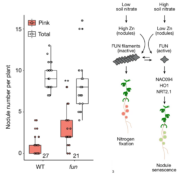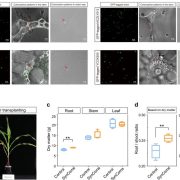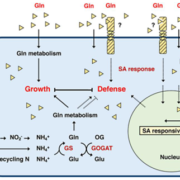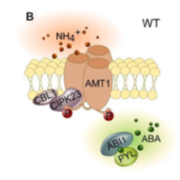Diurnal switches in diazotrophic lifestyle increase nitrogen contribution to cereals
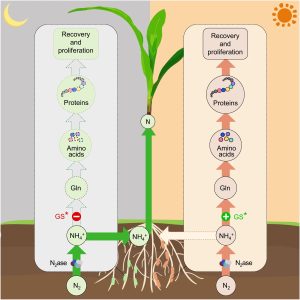 Unlike legumes, which form symbiotic associations with nitrogen-fixing bacteria (diazotrophs), high-yielding cereal crops are usually supplemented with inorganic fertilizers that are both energetically and environmentally problematic. Some non-legumes can obtain nitrogen from associations with free-living diazotrophs, and several strategies are being pursued to optimize such associations. A major challenge is that in most of these conditions the fixed nitrogen is assimilated into glutamine (Gln) by the glutamine synthase (GS) enzyme in the prokaryote, switching off the nitrogen assimilation pathway and retaining most of the fixed nitrogen in the bacterial cell, providing little to the plant. Efforts to modify this pathway leads to poor growth in the bacteria and a high rate of phenotypic reversion. Here, Tang et al. have exploited a mutation in the GS gene that makes the encoded enzyme less sensitive to negative feedback but also cold sensitive, with low activity levels at 23 °C. When this mutation was introduced into the diazotroph Klebsiella oxytoca grown in association with rice or maize, it led to a diurnal pattern of GS activity driven by temperature cycling. During the cooler nighttime, nitrogen fixed by the bacteria is excreted and available to the plant, but during the warmer daytime the active GS enzyme retains the nitrogen in the prokaryotic cell. This diurnal cycling allows the prokaryote time to recover and proliferate, improving nitrogen donation to the crop. (Summary by Mary Williams @PlantTeaching) Nature Comms. 10.1038/s41467-023-43370-4
Unlike legumes, which form symbiotic associations with nitrogen-fixing bacteria (diazotrophs), high-yielding cereal crops are usually supplemented with inorganic fertilizers that are both energetically and environmentally problematic. Some non-legumes can obtain nitrogen from associations with free-living diazotrophs, and several strategies are being pursued to optimize such associations. A major challenge is that in most of these conditions the fixed nitrogen is assimilated into glutamine (Gln) by the glutamine synthase (GS) enzyme in the prokaryote, switching off the nitrogen assimilation pathway and retaining most of the fixed nitrogen in the bacterial cell, providing little to the plant. Efforts to modify this pathway leads to poor growth in the bacteria and a high rate of phenotypic reversion. Here, Tang et al. have exploited a mutation in the GS gene that makes the encoded enzyme less sensitive to negative feedback but also cold sensitive, with low activity levels at 23 °C. When this mutation was introduced into the diazotroph Klebsiella oxytoca grown in association with rice or maize, it led to a diurnal pattern of GS activity driven by temperature cycling. During the cooler nighttime, nitrogen fixed by the bacteria is excreted and available to the plant, but during the warmer daytime the active GS enzyme retains the nitrogen in the prokaryotic cell. This diurnal cycling allows the prokaryote time to recover and proliferate, improving nitrogen donation to the crop. (Summary by Mary Williams @PlantTeaching) Nature Comms. 10.1038/s41467-023-43370-4


